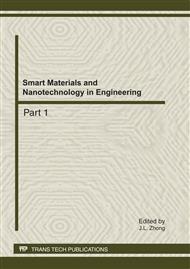p.113
p.119
p.124
p.128
p.134
p.139
p.147
p.154
p.161
Indipendent and Tandem Expression of a Novel Antimicrobial Peptides Plectasin in Escherichia coli
Abstract:
Plectasin, a novel antimicrobial peptide, is isolated from a saprophytic fungus Pseudoplectania nigrella. Plectasin showed potent antibacterial activity in vitro against Gram-positive, especially the Streptococcus pneumoniae and Streptococcus pneumoniae, including strains resistant to conventional antibiotics. In our previous study, plectasin had been expressed at a high yield as a thioredoxin (Trx) – fused protein in Escherichia coli. However, it couldn’t exhibit the antimicrobial activity unless the Trx-tag had been cleaved, which made the producing process be complicated. Concerning that plectasin has no complex post-translational modification and toxicity on E. coli, on the basis of the former works, we further establish the independent and tandem expression system of plectasin in E. coli. In the present study, the coding sequence of plectasin was obtained from pET32a-PLEC with four primers to amplify the independent and tandem plectasin fragments by overlapping PCR-based gene synthesis, and then cloned into pET22b (+) vector. The recombinant protein was expressed successfully in E. coli with IPTG induction. These works might throw light on the production or study of plectasin, and contribute to the development of novel anti-infectious drugs in the future.
Info:
Periodical:
Pages:
134-138
Citation:
Online since:
September 2011
Authors:
Keywords:
Price:
Сopyright:
© 2012 Trans Tech Publications Ltd. All Rights Reserved
Share:
Citation:


